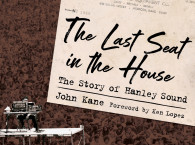 University Press of Mississippi recently released a book which all audioXpress and Voice Coil readers will want to know about and own. The Last Seat in the House: The Story of Hanley Sound is a history of Bill Hanley, Woodstock, the live event industry and the first sound engineer to jam sprawling festivals and rock whole stadiums. The book not only pays tribute to Hanley's work but also reveals many irresistible backstage stories about the Newport Festivals, The Beatles’ final tour and much more.
University Press of Mississippi recently released a book which all audioXpress and Voice Coil readers will want to know about and own. The Last Seat in the House: The Story of Hanley Sound is a history of Bill Hanley, Woodstock, the live event industry and the first sound engineer to jam sprawling festivals and rock whole stadiums. The book not only pays tribute to Hanley's work but also reveals many irresistible backstage stories about the Newport Festivals, The Beatles’ final tour and much more.Known as the "Father of Festival Sound," Bill Hanley (b. 1937, Medford, MA) made his indelible mark as a sound engineer at the 1969 Woodstock Music and Arts Fair. Hanley is credited with creating the sound of Woodstock, which literally made the massive festival possible. Stories of his on-the-fly solutions resonate as legend among festivalgoers, music lovers, and sound engineers. Since the 1950s his passion for audio has changed the way audiences listen to and technicians approach quality live concert sound.
The Last Seat in the House: The Story of Hanley Sound by John Kane is a many-sided journey explored by one man – Bill Hanley. Since the 1950s his appetite for audio has changed the way audiences listen, and how technicians approach, live concert sound.
From his earliest days growing up in the Boston suburb of Medford, to learning his technique and applying it at the Newport Folk and Jazz Festivals, Hanley’s mission was to make live sound better. As the music business advanced, a new and emerging industry did so as well, with Hanley riding its wave. By the end of the 1960s and early 1970s, musicians, managers, and promoters began to expect more than atypical, primitive PA system. They wanted better sound and Hanley was there to help.
The Last Seat in the House: The Story of Hanley Sound was released by the University Press of Mississippi in early 2020. Each chapter is connected. As Hanley’s life unfolds, one memorable event after the other does as well. The history of Hanley Sound, innovations leading to contemporary concert sound systems, the pop festival movement beginning at Newport, Woodstock, and the post-Woodstock festival fallout are all in this far-reaching and encyclopedic text, with Bill Hanley in the backdrop. As a result, the chapters are treated with a broad range of readers in mind. With over eight years of research, this is the most comprehensive text ever written on the rise of live music, and the technology behind it.
Author, educator, popular music scholar John Kane examines Hanley’s echoing impact on the entire field of sound engineering, that crucial but often-overlooked carrier wave of contemporary music. Hanley’s innovations founded the sound reinforcement industry and launched a new area of technology, rich with clarity and intelligibility. By the early seventies the post-Woodstock festival mass gathering movement collapsed. The music industry shifted, and new sound companies surfaced. After huge financial losses and facing stiff competition, Hanley lost his hold on a business he helped create. By studying both his history during the festivals and his independent business ventures, Kane seeks to present an honest portrayal of Hanley and his acumen and contributions.

Since 2011, Kane conducted extensive research, including over one hundred interviews with music legends from the production and performance side of the industry. These carefully selected respondents witnessed Hanley’s expertise at various events and venues like Lyndon B. Johnson’s second inauguration, the Newport Folk/Jazz Festivals, the Beatles' final tour of 1966, the Fillmore East, Madison Square Garden, and more. The Last Seat in the House will intrigue and inform anyone who cares about the modern music industry.
Recently, John Kane also celebrated the 50th anniversary of the 1969 Woodstock Festival with his recently released book Pilgrims of Woodstock (Indiana University Press). To learn about John Kane's other work Pilgrims of Woodstock with the University Press of Indiana please go to www.pilgrimsofwoodstock.com

www.thelastseatinthehouse.com






